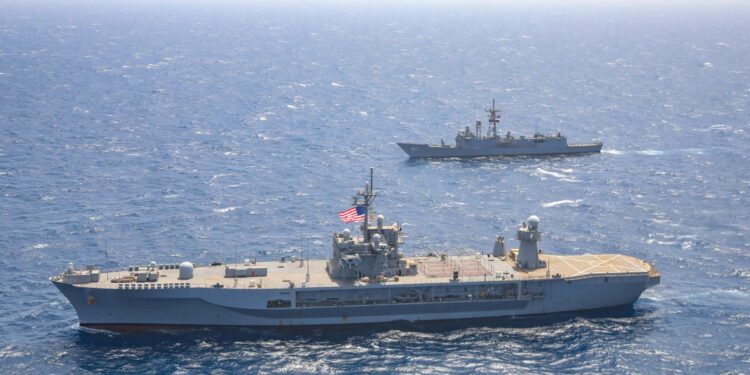The USS Mount Whitney, flagship of the U.S. Sixth Fleet, has arrived in Bar, Montenegro, marking a significant milestone in the ongoing partnership between the United States and Montenegro. This visit underscores the commitment of both nations to enhancing regional security, promoting interoperability, and strengthening diplomatic ties in the strategically important Adriatic region. The deployment of the Mount Whitney highlights the continued U.S. engagement in Southeast Europe amid evolving geopolitical challenges.
USS Mount Whitney Docked in Bar Marks Milestone in U.S.-Montenegro Naval Collaboration
The arrival of the USS Mount Whitney in Bar, Montenegro, signifies a deepening of bilateral naval relations between the United States and Montenegro. This strategic presence underscores shared commitments to regional security, maritime cooperation, and mutual readiness. Throughout its visit, the flagship of the U.S. Sixth Fleet will engage in a series of joint exercises and port calls designed to enhance interoperability and demonstrate the strength of the transatlantic alliance.
Key highlights of the USS Mount Whitney’s visit include:
- Combined maritime drills focusing on humanitarian assistance and disaster response
- Leadership exchanges to foster professional military education and partnership
- Community engagement activities promoting goodwill between U.S. Navy personnel and local residents
| Event | Date | Location |
|---|---|---|
| Joint Naval Exercise | June 12, 2024 | Montenegrin Coastal Waters |
| Command Leadership Summit | June 14, 2024 | Port of Bar |
| Community Outreach | June 15, 2024 | Bar City Center |
Enhancing Joint Readiness Through Combined Training and Strategic Engagement
The recent arrival of USS Mount Whitney in Bar, Montenegro marks a significant milestone in advancing interoperability between U.S. and Montenegrin naval forces. Joint training exercises conducted throughout the deployment focused on sharpening operational coordination, enhancing communication protocols, and reinforcing maritime security tactics critical to safeguarding regional waters. These efforts allowed personnel to exchange best practices and build a shared understanding of procedures, directly contributing to more agile and cohesive responses during potential crises.
Emphasizing strategic engagement, the combined activities also included simulated maritime interdiction operations and search-and-rescue drills, which elevated both forces’ readiness levels. The integration of multinational teams fostered mutual trust and highlighted areas for further capability development. Key objectives achieved through this partnership include:
- Enhanced joint command and control structures
- Improved interoperability in communication systems
- Strengthened tactical proficiency in littoral environments
| Training Element | Focus Area | Outcome | |
|---|---|---|---|
| Maritime Interdiction | Boarding Procedures | Streamlined Coordination | |
| Search & Rescue | Emergency Response | Faster Response Times | |
| Communication Drills | It looks like the last table row is incomplete. Here’s the completed row to match the style and content of the previous rows: | ||
| Communication Drills | Interoperability | Enhanced Clarity |
| Training Element | Focus Area | Outcome |
|---|---|---|
| Maritime Interdiction | Boarding Procedures | Streamlined Coordination |
| Search & Rescue | Emergency Response | Faster Response Times |
| Communication Drills | Interoperability | Enhanced Clarity |
If you want me to help with anything else, just let me know!
Recommendations for Expanding Multinational Maritime Security Initiatives in the Adriatic Sea
The ongoing collaboration exemplified by the USS Mount Whitney’s arrival in Bar underscores the urgent need to broaden maritime security frameworks within the Adriatic Sea. Strengthening information sharing protocols among NATO allies and regional partners can significantly enhance real-time situational awareness, enabling rapid response to emerging threats such as smuggling, trafficking, and illegal fishing. Emphasis should be placed on joint training exercises that not only improve interoperability but also foster trust and transparency among participating navies. This operational synergy will serve as a force multiplier, making security efforts more effective and sustainable.
To further institutionalize these efforts, establishing a centralized Adriatic Maritime Security Coordination Center could streamline multi-national operations and intelligence dissemination. This structure should integrate:
- Shared surveillance technologies leveraging satellite and drone capabilities;
- Unified command protocols that standardize engagement rules and crisis response;
- Regular multilateral summit meetings to address policy and strategic adjustments.
The table below illustrates comparative maritime security assets currently deployed by regional partners, underscoring opportunities for resource optimization through combined efforts:
| Country | Patrol Vessels | Surveillance Drones | Naval Bases |
|---|---|---|---|
| Montenegro | 5 | 3 | 2 |
| Croatia | 8 | 5 | 3 |
| Albania | 4 | 2 | 1 |
| Italy | 12 | 10 | 5 |
By capitalizing on the complementary strengths of each nation’s naval capabilities and fostering a cohesive maritime security doctrine, the Adriatic Sea region can be transformed into a model of multinational cooperation and resilience. Such expansion not only reinforces regional stability but also bolsters U.S. strategic partnerships in Southeast Europe.
Closing Remarks
The arrival of USS Mount Whitney in Bar, Montenegro, marks a significant milestone in the ongoing collaboration between the U.S. Navy and Montenegrin forces. This deployment not only underscores the commitment of the United States to regional security and stability in the Balkans but also reinforces the strong diplomatic and military ties between the two nations. As joint exercises and cooperative missions continue, both countries aim to enhance interoperability and advance mutual interests, contributing to a secure and prosperous future in the region.
















